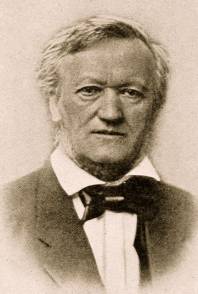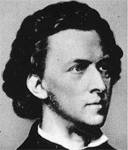Romantic Era: Composers, Conductors, and Performers, continued

![]() Listen to Richard Wagner's (1813-1883) "Flight of the Valkyries":
Listen to Richard Wagner's (1813-1883) "Flight of the Valkyries":
German composer Richard Wagner (1813-1883) is most well-known for his opera as well as the many innovations he brought to the genre. Wagner wrote both the libretto (the words) and the music for his operas. He created the idea of Gesamtkunstwerk, which translated means “Total work of art,” or the idea that in an opera, all elements worked together to create a seamless whole, and no element was more important than another: music, words, and visual elements of drama. His idea was embodied in his four-opera masterwork, Der Ring des Niebelung (The Ring of the Niebelung). This opera cycle includes many famous characters from German lore and mythology, including Wotan, Siegfried, Siegmund, and the Valkyrie Brunhilde. Wagner was a master at creating a musical leitmotif that represented an idea (such as fate) or a person. His operas contain some of the most easily identifiable melodies, including the famous Flight of the Valkyries (from Wagner’s opera Die Valkure) and the Wedding March/Bridal Chorus, from Wagner’s opera Lohengrin.

![]() Listen to Frédéric Chopin's "Fantasie" (1810-1849) Impromptu, Op. 66:
Listen to Frédéric Chopin's "Fantasie" (1810-1849) Impromptu, Op. 66:
Polish composer Frederic Chopin (1810-1849) composed a number of works, all featuring the piano. Like Liszt, Chopin was known as both a performer and composer, and had a lyrical and sensitive style. He traveled widely across Europe performing, and became one of the Romantic Era’s first musical “superstars.” Chopin was influenced by the folk music of his native Poland, including songs with Polish lyrics.
![]() Listen to Chopin's Waltz in D-flat Major, "Minute Waltz":
Listen to Chopin's Waltz in D-flat Major, "Minute Waltz":
Attribution: Play by Muriel Nguyen Xuan, recording by Stéphane Magnenat Muriel Nguyen Xuan and Stéphane Magnenat [GFDL (http://www.gnu.org/copyleft/fdl.html) or CC BY-SA 4.0-3.0-2.5-2.0-1.0 (https://creativecommons.org/licenses/by-sa/4.0-3.0-2.5-2.0-1.0)], via Wikimedia Commons
![]() Listen to Chopin's Polonaise No. 6 in A flat minor: “Heroique” (2 minute 20 sec. clip):
Listen to Chopin's Polonaise No. 6 in A flat minor: “Heroique” (2 minute 20 sec. clip):
Attribution: Performed by Kristian Cvetković - this file is licensed under the Creative Commons Attribution ShareAlike 2.5 License Frédéric Chopin [CC BY-SA 2.5 (https://creativecommons.org/licenses/by-sa/2.5)], via Wikimedia Commons.
![Attribution: Tchaikovsky sitted portrait by Franciszek de Mezer (1829-1919) (Tchaikovsky Research) [Public domain or Public domain], via Wikimedia Commons](resources/images/revTchaikovsky_sitted_portrait_by_Franciszek_de_Mezer_(1890).fw.png)
Russian composer Pytor Illyich Tchaikovsky (1840-1893) created some of the most popular and well-known works of his era. Most people today recognize the melodies and themes from the overtures to his many ballets, which include Swan Lake, Sleeping Beauty, and The Nutcracker. His themes are lyrical and enduring, as well as displaying new harmonies and musical elements that gained prominence during this era. Tchaikovsky’s training in Western Classical music, combined with the Russian folk music from his childhood, contributed to his unique style. Tchaikovsky, Wagner, and Chopin are all examples of composers who used musical ideas from their native countries in their music, which is a characteristic of this era known as nationalism.
![]() Listen to Tchaikovsky from the ballet Swan Lake, Opus 20, No. 2 , Waltz:
Listen to Tchaikovsky from the ballet Swan Lake, Opus 20, No. 2 , Waltz:
Attribution: John Barbirolli conducting the London Philharmonic Orchestra, Pyotr Ilyich Tchaikovsky [Public domain], via Wikimedia Commons.
![]() Listen to Tchaikovsky from From the ballet The Nutcracker: Waltz of the Flowers:
Listen to Tchaikovsky from From the ballet The Nutcracker: Waltz of the Flowers:
Attribution: Pyotr Ilyich Tchaikovsky [Public domain], via Wikimedia Commons.
![]() Listen to Tchaikovsky Dance of the Sugar Plum Fairy.:
Listen to Tchaikovsky Dance of the Sugar Plum Fairy.:
Attribution: Pyotr Ilyich Tchaikovsky [CC BY 3.0 (http://creativecommons.org/licenses/by/3.0)], via Wikimedia Commons.
